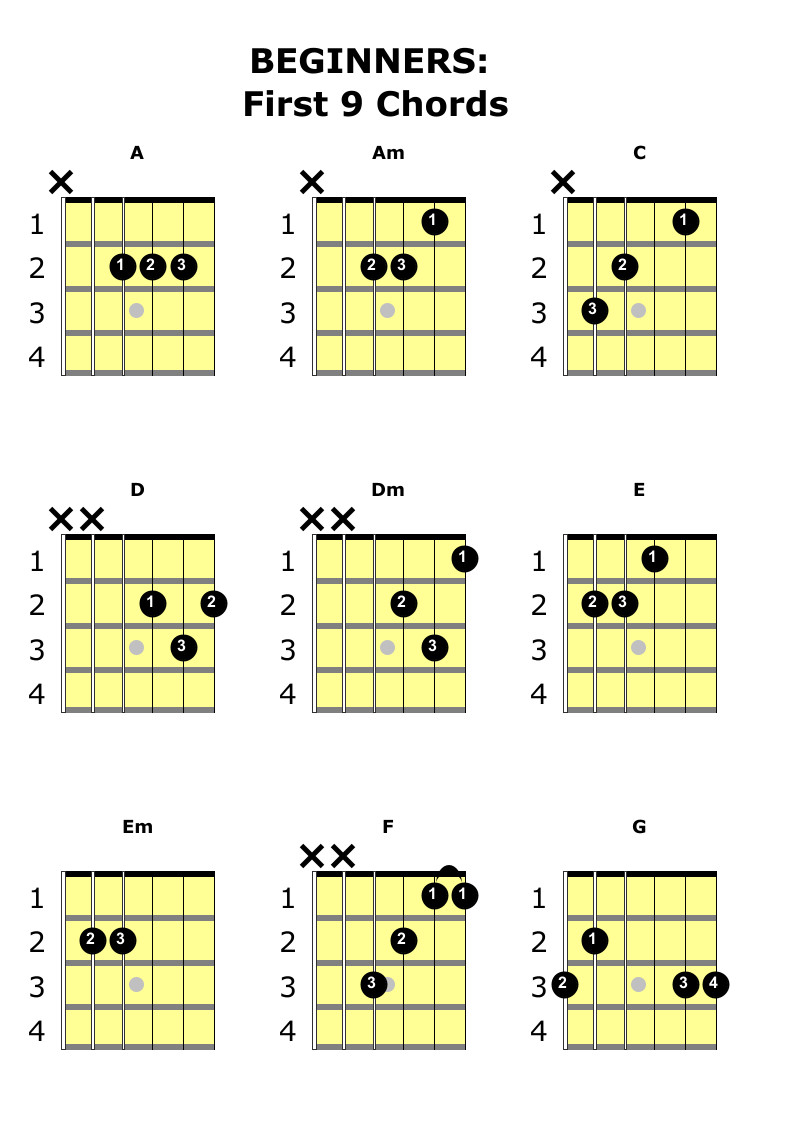Learning guitar is an exciting journey, and getting started with the right chords is key to making quick progress. For anyone picking up the guitar for the first time, mastering a few basic chords is the perfect launchpad. In fact, focusing on a set of fundamental open chords can unlock a huge number of songs and build a solid foundation for your guitar playing. As a guitar teacher with years of experience guiding beginners, I always recommend starting with these 9 essential chords. They are your gateway to countless songs and will make your initial learning experience much more rewarding.
 Diagram of the 9 basic guitar chords for beginners: A, Am, C, D, Dm, E, Em, F, G, showing finger positions on the fretboard.
Diagram of the 9 basic guitar chords for beginners: A, Am, C, D, Dm, E, Em, F, G, showing finger positions on the fretboard.
There are several compelling reasons why these 9 chords are ideal for beginners taking their first steps in guitar playing:
Firstly, with just these 9 basic guitar chords, you can already play a surprisingly vast repertoire of songs. These chords are incredibly versatile and appear in countless popular tunes across various genres. What’s even better is that these are all open position chords, meaning they are played in the first few frets of the guitar and utilize open strings, making them easier to fret and sound clear. Furthermore, if you explore using a capo later on, the number of songs you can play with these same 9 chords expands even further, giving you incredible flexibility.
Secondly, these chords are significantly easier to learn than barre chords. Barre chords, which require you to press down multiple strings with one finger across the fretboard, can be quite challenging for beginners. It’s best to postpone learning barre chords until you’ve built some finger strength andCallus development, typically after a couple of months of regular playing. Starting with these basic chords allows you to focus on developing essential fretting hand techniques and getting comfortable with chord changes without the added difficulty of barre chords.
Finally, learning to play songs using these chords provides a massive confidence boost. Successfully playing along to your favorite songs early on is incredibly motivating and encourages you to continue learning and progressing. This positive reinforcement is crucial in the initial stages of learning guitar, helping you overcome potential frustrations and stay engaged with your practice. Mastering these beginner guitar chords will fuel your passion and give you the momentum to tackle more advanced guitar concepts in the future.
Learn Your First Chords with a Step-by-Step Guide
Learning your first guitar chords can feel overwhelming at first. Getting your fingers to cooperate, remembering the shapes, and smoothly transitioning between chords all take practice. To help you navigate this initial learning curve, I’ve developed a detailed video course specifically designed for beginners like you. My “First 9 Chords For Beginners” video course breaks down each chord into easy-to-follow video lessons, providing a convenient and quick reference guide that you can revisit anytime.
 Beginner guitar player learning basic chords in a lesson, focused on hand position and finger placement on the guitar neck.
Beginner guitar player learning basic chords in a lesson, focused on hand position and finger placement on the guitar neck.
The course is structured into individual video chapters, with each lesson ranging from approximately 3 to 5 minutes. This bite-sized format makes it easy to focus on one chord at a time and learn at your own pace. The course covers everything from the very basics to ensure you get a solid understanding:
- Introduction: Setting the stage and getting you excited about learning.
- How To Read Chord Box Diagrams: A crucial skill for understanding chord charts.
- Individual Chord Lessons: Dedicated videos for A, Am, C, D, Dm, E, Em, F, and G chords, each demonstrating finger placement and strumming techniques.
- Outro: Wrapping up and encouraging your next steps.
To give you a taste of what the course offers, you can check out a free preview lesson – the “C Chord” chapter – to get started right away.
Starting your guitar journey with these basic guitar chords is the most effective way to begin. They provide a solid foundation, enable you to play countless songs, and build the confidence you need to keep learning and progressing. Dive in, practice regularly, and enjoy the rewarding experience of playing music on the guitar!
